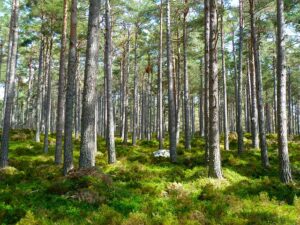Introduction
Pollarding trees is a timeless practice, enhancing aesthetics, safeguarding tree health, and ensuring safety. Learn about the right timing, tree choices, essential tools, and follow-up care. Join us as we delve into this ancient art, its significance, and best practices.
What is Pollarding?
Pollarding is a horticultural technique that entails selectively removing the upper branches of a tree. This promotes the growth of a dense and lush canopy of foliage and branches. Initially, it was done to prevent trees from growing too high for firewood and fodder purposes. Today, it is primarily employed for aesthetic reasons, and to maintain trees at a predetermined height.
Brief History of Pollarding
The practice of pollarding dates back to the medieval times when it was necessary to prevent the trees from overshadowing crops, to provide firewood, and to produce fodder for livestock. This technique allowed trees to produce shoots annually that could be harvested, while also preventing the growth from being accessible to grazing animals. Over the centuries, pollarding became less prevalent as other means of obtaining firewood and fodder became available. In the modern era, this technique is largely used for maintaining the health and aesthetics of trees, particularly in urban settings. By understanding its rich history, we can appreciate pollarding not just as a horticultural task, but also as a living link to our agricultural past.
Reasons for Pollarding Trees
A. Enhancing Aesthetic Appeal
Pollarding can remarkably enhance the aesthetic appeal of trees. It fosters a unique, controlled growth pattern that can add visual interest to any landscape. Regularly pollarded trees develop a distinct and attractive ‘lollipop’ shape, offering a dramatic and artistic touch to garden design.
What are examples if trees that are pollarded?
Some common trees that are often pollarded include willows, oaks, maples, and lindens. However, almost any tree with a strong central leader can be pollarded to achieve a similar effect.
B. Maintaining Trees at a Predetermined Height
One of the main reasons for pollarding is to keep trees at a specific height. This can be particularly useful in urban areas where there may be power lines or other structures that need to be kept clear. Pollarding allows for the trees to continue growing, while also preventing them from becoming too tall and posing a risk.
C. Maintaining Tree Health
From a horticultural perspective, pollarding can contribute to promoting tree health. By removing weak or diseased branches, pollarding can prevent the spread of disease and insect infestation, fostering stronger and healthier growth. It also invigorates the tree, stimulating the growth of youthful, vigorous branches.
D. Ensuring Safety
Safety is another crucial reason for pollarding trees. Overgrown or weak branches can pose a potential risk of falling, causing damage to property or injury. Regular pollarding can mitigate such risks by maintaining the tree at a safe height and removing potentially hazardous branches.
Process of Pollarding Trees
A. Choosing the Right Time
The optimal time for pollarding is usually late winter or early spring, when the tree is dormant but on the cusp of its growth season. This timing allows the tree to heal rapidly, with fresh growth appearing in the springtime. However, the specific timing can vary depending on the species of the tree.
B. Selecting the Correct Trees
Not all trees are suitable for pollarding. Certain species respond well to this process, including willows, poplars, and some types of oaks and maples. Others, such as birches, beeches, and most conifers, may not withstand the procedure well. Therefore, it’s essential to consult with a knowledgeable arborist before attempting to pollard any tree.
C. Necessary Tools
The tools required for pollarding can range from simple hand tools to more specialized equipment. To properly maintain your trees, it is important to have the right tools. For smaller branches, a pair of high-quality pruning shears will suffice, while larger limbs may require a pruning saw. If you need to reach high branches, a pole saw might be necessary. Remember to keep your tools sharp and clean to ensure clean cuts and prevent the spread of diseases.
D. Step-by-Step Procedure
- Begin by identifying the branches to be pollarded. These should be younger branches that have not yet developed a thick bark.
- Make your cut just above a pair of buds or a branch junction. The cut should be flat and clean to facilitate rapid healing and prevent disease.
- Continue this process, working your way around the tree and maintaining a balanced appearance. Remember to make sure the tree’s height is managed and kept at a safe level.
- Once the process is complete, dispose of the cut branches responsibly and clean your tools thoroughly. Repeat this process annually or biannually as necessary to maintain the desired shape and size.
Remember, pollarding is a significant procedure that can dramatically affect a tree’s health and appearance. It should only be undertaken with a clear understanding of the process and the specific needs of the tree in question.
What is the difference between topping and pollarding?
Both topping and pollarding involve the cutting back of branches, but they are not the same practice. Topping is often referred to as “heading” or “rounding over,” and it involves removing large portions of a tree’s crown, usually without regard for the tree’s natural structure or growth pattern. This can result in weak branch attachments, stress on the tree, and an unsightly appearance.
On the other hand, pollarding is a more controlled technique that involves removing smaller, younger branches to promote new growth and maintain the tree’s overall size and shape. This practice requires specific cuts made at strategic locations on the tree, resulting in a healthier and more aesthetically pleasing outcome.
It is essential to understand these differences as improper topping can cause significant damage to a tree, while pollarding, when done correctly, can benefit the tree’s health and longevity. When in doubt, consult with a certified arborist for guidance on the best approach for your specific tree.
In conclusion, pollarding is a vital technique for managing certain species of trees and should be done carefully and thoughtfully.
Aftercare for Pollarded Trees
A. Watering and Fertilizing
After pollarding, trees demand enhanced care to ensure healthy regrowth. This includes regular watering and the right fertilization. Newly pollarded trees may require more water than mature, established trees, especially during dry periods. Fertilizing is also crucial; a slow-release fertilizer high in nitrogen can promote vigorous growth and help the tree recover from the stress of pruning.
B. Monitoring Growth
Close monitoring of the tree’s growth following pollarding is essential. This means regularly inspecting the tree for any signs of disease or pest activity, as these issues can become more prevalent after heavy pruning. It’s also critical to watch for weak or crowded new growth, which may need to be thinned out to maintain the tree’s health and appearance.
C. Scheduling Regular Pruning
Finally, regular pruning schedules should be established and followed. Depending on the tree species, this could be annually or every few years. Regular pruning helps maintain the desired size and shape of the tree, prevents the growth from becoming too dense, and ensures the overall health and longevity of the tree. Always remember, it’s best to consult with a certified arborist when planning your tree’s care and maintenance.
Potential Risks, Challenges, and Solutions
A. Risk of Disease
Pollarding, while beneficial, can make trees more susceptible to certain diseases. The large cuts made during pollarding may leave the tree vulnerable to infections, pathogens, or pests. These can infiltrate the tree through the open wounds and cause decay, impacting the tree’s overall health.
B. Over-Pollarding
Over-pollarding is another potential risk. This occurs when trees are pruned too aggressively or too frequently, leading to excessive stress and weakening of the tree. Over-pollarded trees may struggle to recover, have stunted growth, or even die.
C. Solutions and Preventive Measures
To mitigate the risks associated with pollarding, a few solutions and preventive measures can be implemented. Firstly, ensure proper wound care. After pollarding, the wounds should be cleaned and treated promptly to reduce the risk of disease. Secondly, adhere to a proper pollarding schedule, taking into consideration the specific needs of the tree species. Finally, consider consulting with a certified arborist who can provide expert guidance and carry out the pollarding in a way that minimizes harm to the tree.
Conclusion
A. Importance and Benefits of Pollarding
In conclusion, pollarding is a highly effective tree management technique when done correctly. It offers a myriad of benefits, from maintaining a tree’s size and shape to promoting its health and longevity. Moreover, pollarding keeps the growth from becoming overwhelmingly dense, and it can be a brilliant aesthetic choice for landscapes.
B. Encouraging Best Practices
It’s crucial to remember that while pollarding is beneficial, it requires careful execution to avoid potential risks. Adhering to best practices such as proper wound care, following a species-specific pollarding schedule, and consulting with a certified arborist can ensure the success of the process. The health and beauty of our trees largely depend on our care, so let us always strive to protect and nurture them.



